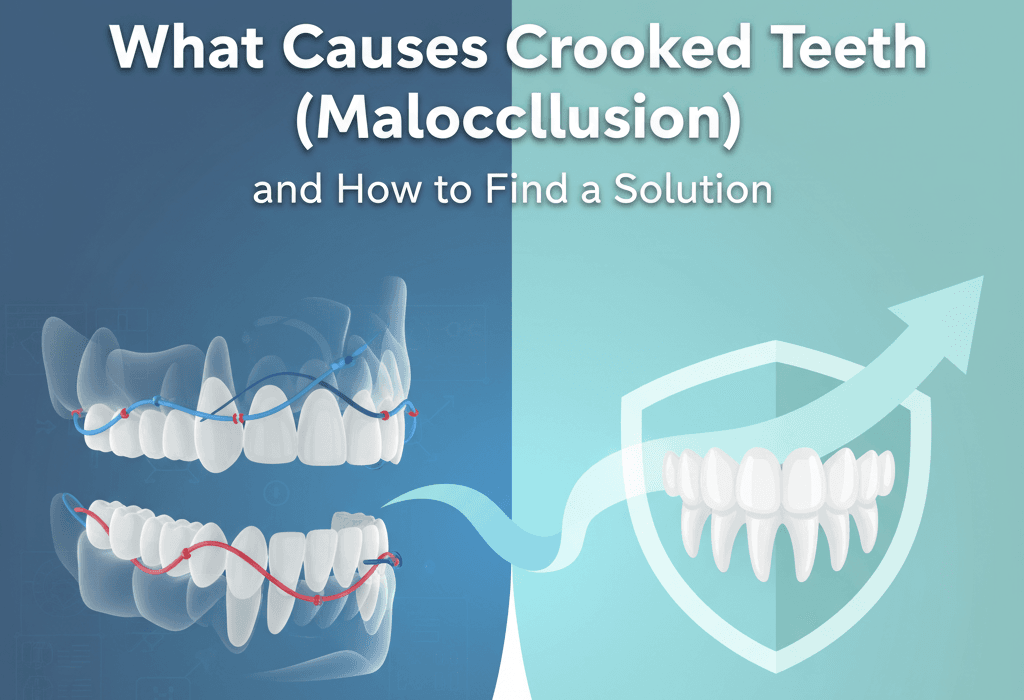If you’ve ever wondered why your teeth don’t line up perfectly—or if you’ve noticed a child’s teeth coming in with overlaps or gaps—you’ve encountered a condition known as malocclusion. Malocclusion is the clinical term for a misalignment of the teeth or an improper fit between the upper and lower dental arches, often referred to as a “bad bite”. Unlike a simple tooth chip, the causes of crooked teeth are complex, often stemming from a combination of genetic and environmental factors that influence jaw and dental development. Understanding the root cause of your misalignment is the first essential step toward achieving a healthy, straight smile.
Table of Contents:
- What Is Malocclusion?
- The 5 Primary Causes of Crooked Teeth
- Is Treatment Necessary?
- Conclusion
What Is Malocclusion?
Malocclusion literally means “bad bite” and describes any deviation from an ideal occlusion, where the upper arch slightly overlaps the lower arch. This condition affects not just the aesthetics of a smile but also crucial functions like chewing and speaking. It occurs when there is a mismatch between the size of the jaw and the size of the teeth, or an issue with the relative position of the upper and lower jaws.
Orthodontists classify malocclusions into different types:
- Class 1: The most common type, where the bite is normal but the teeth are crowded, spaced, or rotated.
- Class 2 (Overbite/Retrognathism): The upper jaw and teeth severely overlap the bottom jaw and teeth.
- Class 3 (Underbite/Prognathism): The lower jaw protrudes, causing the lower teeth to overlap the upper teeth.
The 5 Primary Causes of Crooked Teeth
The etiology of misaligned teeth is multifactorial, meaning several distinct influences contribute to their development.
- Genetics and Heredity: This is considered the most significant factor. You can inherit a jaw that is too small for your teeth, a misaligned bite (like an overbite or underbite), or a tendency for crowding or uneven spacing directly from your parents.
- Childhood Oral Habits: Certain repetitive behaviors during early development can exert pressure on the teeth and alter the shape of the jaw. These habits include:
- Thumb-sucking or prolonged pacifier/bottle use beyond age three.
- Tongue thrusting, where the tongue presses against the front teeth during swallowing.
- Mouth breathing, which can change how the tongue rests and lead to poor upper jaw development.
- Jaw and Tooth Size Discrepancy: Malocclusion often results from a simple size mismatch. If the jaw is too small, teeth become crowded and overlap. Conversely, a larger-than-average jaw can result in excessive gaps or spacing (diastema).
- Trauma and Tooth Loss: Injuries to the face or jaw can directly displace teeth or affect bone structure. Premature loss of baby teeth or the loss of permanent teeth without replacement can cause the remaining teeth to shift, drift, or lean into the empty space, disrupting the arch and causing new crowding.
- Dental Disease and Aging: Poor oral hygiene can lead to severe gum disease (periodontitis), which causes gum recession and bone loss. As the support structure weakens, the teeth can loosen and shift out of alignment. Additionally, teeth naturally tend to shift forward throughout life, often causing late-onset crowding in the lower front teeth.
Is Treatment Necessary?
While some people choose to live with slightly crooked teeth, moderate to severe malocclusion can lead to significant oral health problems. Misaligned teeth are notoriously difficult to clean properly, increasing the risk of tooth decay (cavities) and periodontal disease. They can also cause abnormal wear on the tooth surfaces, jaw strain, and even difficulty with eating and speech.
Common treatment options include:
- Orthodontic Braces: Traditional metal, ceramic, or lingual braces use brackets and wires to apply constant, mild pressure to shift teeth into their correct positions.
- Clear Aligners (e.g., Invisalign): A series of custom-made, clear, removable trays that gradually move the teeth.
- Cosmetic Options: For minor issues, veneers or dental bonding can create the appearance of straighter teeth by covering imperfections without changing the actual alignment.
Conclusion
The journey to a straighter smile begins with understanding its origins. What often appears to be a purely cosmetic issue can stem from deep-seated genetic factors or habits developed in childhood. Without proper diagnosis from a dental professional, the alignment problems can progress, leading to issues like decay, gum disease, and discomfort. Recognizing these causes is the necessary first step toward finding a definitive solution. You don’t have to manage the complexities of malocclusion alone. Our dedicated dental team specializes in diagnostic methods that can accurately identify the cause of your misalignment, leading you to the proper treatment—whether it’s orthodontics, surgery, or a cosmetic solution. If you are ready to find a definitive path to a healthier, more comfortable smile, we encourage you to schedule a consultation with our dental team today. Let us help you put the alignment concerns behind you and regain confidence and quality of life.
